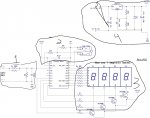Newbie- Trying to learn Picaxe. Need any help I can get.
(Please dont post any links for purchase some premade unit, this is purely educational.)
I'm working on making a bench supply, but have been unable to find any information to help.
So far what I have is-
12V Supply-5A-Laptop Supply
24V Supply-3A-Laptop Supply
A ATX Powersupply- Plan on this being my variable supply
: Off the ATX supply- 5v supply
Currently have 2 08m2 Picaxe chips.
What I am aiming to do seems simple enough, but need some help getting started.
The way I see the panel layout would be two 2 way switches- Switch 1. 5V, Variable Switch 2. 12V,24V
W a Potentiometer to set the Variable. I understand this supply is redundant, but just using up scrap supplies while learning Picaxe.
I have a RGB LED that I plan on using for an indicator for supply B=5V G=12 R=24
Ultimately- I plan on having 2 7 Segment displays for this. But Ill start easy
From what I have gathered thus far, I need to utilize the Readadc command. Correct? Or do i calibrate the Picaxe to read different resistance values?
If I go with the Readadc, then I can set known values 5V=24V 3.5V=12V 1V=5V
Could I just use 3 separate voltage divider circuits for this? Or would there be a more efficient route to head?
Posts I have ran across similiar to this project seem to deviate into more of a discussion about impedance and resolution.
The range between my set voltages is wide, so I dont think this is something to really worry about?
Plenty of room in my encloser and lots of fans, so heat dissipation shouldent be an issue.
I apologize if this has already been done in another thread
Thanks for any help on getting started
(Please dont post any links for purchase some premade unit, this is purely educational.)
I'm working on making a bench supply, but have been unable to find any information to help.
So far what I have is-
12V Supply-5A-Laptop Supply
24V Supply-3A-Laptop Supply
A ATX Powersupply- Plan on this being my variable supply
: Off the ATX supply- 5v supply
Currently have 2 08m2 Picaxe chips.
What I am aiming to do seems simple enough, but need some help getting started.
The way I see the panel layout would be two 2 way switches- Switch 1. 5V, Variable Switch 2. 12V,24V
W a Potentiometer to set the Variable. I understand this supply is redundant, but just using up scrap supplies while learning Picaxe.
I have a RGB LED that I plan on using for an indicator for supply B=5V G=12 R=24
Ultimately- I plan on having 2 7 Segment displays for this. But Ill start easy
From what I have gathered thus far, I need to utilize the Readadc command. Correct? Or do i calibrate the Picaxe to read different resistance values?
If I go with the Readadc, then I can set known values 5V=24V 3.5V=12V 1V=5V
Could I just use 3 separate voltage divider circuits for this? Or would there be a more efficient route to head?
Posts I have ran across similiar to this project seem to deviate into more of a discussion about impedance and resolution.
The range between my set voltages is wide, so I dont think this is something to really worry about?
Plenty of room in my encloser and lots of fans, so heat dissipation shouldent be an issue.
I apologize if this has already been done in another thread
Thanks for any help on getting started

